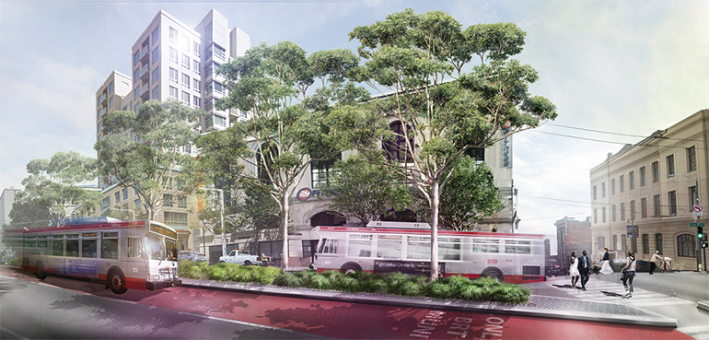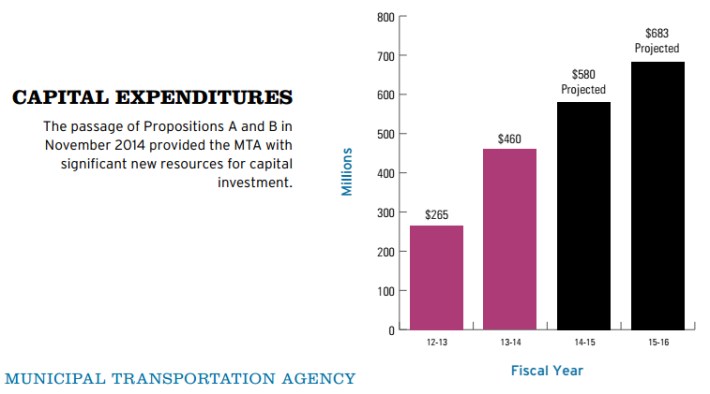
San Francisco Mayor Edwin Lee released his 455-page budget proposal on Tuesday. It includes $9.6 billion in fiscal year 2016-17 for transportation, police officers, and street cleaning, a $700 million increase in funds. The fiscal year runs from July 1 of this year until June 30 of next year.
The transportation section runs from pages 315 to 322--here are some highlights:
The proposed budget includes an additional $15 million in FY 2016-17 and $62.2 million in FY 2017-18 in new transportation funding. Once fully implemented in FY 2017-18, these investments will provide $28.7 million for Muni fleet, infrastructure upgrades, and transit optimization, $9.6 million for equity and affordability initiatives, $14.3 million to support regional transit projects and fleet needs, and $9.6 million to fully fund street safety projects that are consistent with the City’s Vision Zero policy.
Lee was presenting the budget as a step forward for the city's transit programs and safety initiatives.
"The result is the SFMTA’s first-ever $1 billion operating budget to improve transit performance and reliability. The SFMTA operates the nation’s eighth largest public transit system and it serves every neighborhood," said Lee in his Proposed Balanced Budget Speech, on Tuesday.
"To invest in the future of Muni, my proposed budget also includes significant investments in capital improvements, including nearly $26 million for new hybrid buses and light rail vehicles, and $5.9 million in street and pedestrian safety projects to move the City closer to its Vision Zero goal of eliminating all traffic fatalities by 2024," he added.
Lee also noted that the budget maintained funding for Muni's free programs for seniors, youth, and people with disabilities.
"This budget contains very robust investment in a number of critical transportation needs," said Supervisor Scott Wiener, whose Proposition B is responsible for much of the growth in the transportation and safe streets portion of the budget. Prop B instituted a city charter amendment mandating annual increases in the share of general funds set aside for transportation, based on population growth. In this budget, Prop. B is "pushing $30 million or more over to transportation," he said.
Over the next two weeks, the Budget Committee of the San Francisco Board of Supervisors will be taking a look at the document and making further recommendations.

Also from the budget proposal:
The MTA’s FY 2016-17 and 2017-18 Capital Improvement Program (CIP) includes $1.9 billion for projects across 12 capital programs. These projects include infrastructure investments as well as various procurements and other one-time initiatives that improve the safety, reliability, and efficiency of the transportation system. The capital budget addresses infrastructure needsrelated to transit reliability, street safety, state of good repair, facilities, communications andinformation technology, taxi regulation, system safety and accessibility. Capital projects reflect theMTA Board of Directors’ adopted policies and plans including Transit First, Vision Zero, the San Francisco Pedestrian Strategy, the MTA Bicycle Strategy, the City and County of San Francisco’s Adopted Area Plans, the MTA FY 2013-18 Strategic Plan, and the San Francisco County Transportation Plan.
The ability to grow the budget is due to the strong economy. However, the mayor's proposal also depends on a sales tax increase to balance the budget. "It is budgeted on the assumption that a half-cent tax for transportation will pass this November," said Wiener. "It includes $105 million a year for roads, Muni, capital investment, support for BART vehicles, and for street safety improvements."
The tax is actually a .75 percent increase, with a half-cent dedicated to transportation and .25 for homelessness, explained Wiener.
So what happens if the sales tax increase doesn't pass this November?
Fortunately, since this is going into the general fund, a simple majority is all that's required to pass it, rather than the normal two-third majority for a dedicated tax. But it will be accompanied by a charter amendment to set aside the transportation and safe street funds.
That may be why transit and safe-streets advocates are cautiously optimistic.
"We look forward to analyzing the details...a good chunk of the increase is going to transportation," said Thea Selby, chair of the SF Muni Transit Riders. "You need only look at the N Judah in the morning to see how San Franciscans need more service--more buses and trains, more often."




